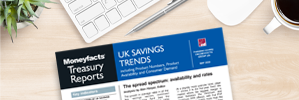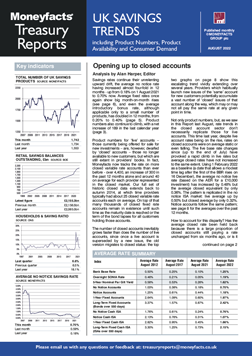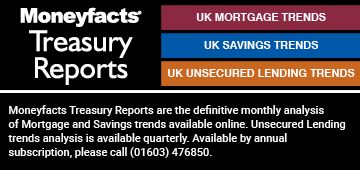Rachel Springall, Finance Expert at Moneyfacts, said:
“Savings rates continued to climb month-on-month, for the seventh consecutive month, with both the average one-year and longer-term fixed bonds rates reaching their highest levels since 2012. The average one-year fixed bond arena remains extremely competitive, with the average return breaching 2% for the first time in a decade. Product choice across the savings spectrum also improved, getting closer to levels not seen since March 2020.
“The average one-year fixed bond market was heated during August, as we saw the average rate rise by 0.32% month-on-month, up from 1.97% to 2.29% – the highest monthly improvement since our records began. Those savers looking to invest for longer would also see rate rises on longer-term fixed bonds, and due to the volatility of rate changes, the average shelf life for a fixed bond fell drastically to 27 days, down from 40 days a month prior. Providers are moving quickly in response to competition, so savers can now find the top short-term fixed bonds paying rates beyond 3%.
“The back-to-back base rate rises have had a positive influence on variable savings rates, and this, along with notable competition, has seen the average easy access rate rise to its highest level since 2012. The recovering momentum of this arena has seen the average rate rise from 0.17% to 0.84%, standing around five times more than last year. However, not every account has improved over this period, so it’s vital savers compare their existing accounts and switch to take advantage of the current competition. Notice accounts are also seeing notable improvements, with the average rate standing at the highest level in over ten years, with top rates breaching 2%.
“ISAs are improving, however, there remains a notable rate gap between fixed bonds and ISAs, so savers will need to weigh up any tax-free allowance they have before they commit. According to the Bank of England, Cash ISA outflows continued in July, rising to £647 million, from £210 million a month prior. As interest rates continue to rise, those savers who have large pots may breach their Personal Savings Allowance, so we could see net outflows change. However, the cost of living crisis may well lead to savers withdrawing cash to cover costs.
“Accessibility continues to be a desirable aspect of a savings account, and during July there was an inflow of £709 million into interest-bearing sight deposits, according to the Bank of England. However, the attitude among savers may be volatile in the months to come, both for those chasing down fixed rates and those who can withdraw their savings to cover rising living costs. To attract savers, providers will need to respond quickly to compete with their peers and offer a range of products to suit specific needs.”
Rachel Springall, Finance Expert at Moneyfacts, said:
“Savings rates continued to climb month-on-month, for the seventh consecutive month, with both the average one-year and longer-term fixed bonds rates reaching their highest levels since 2012. The average one-year fixed bond arena remains extremely competitive, with the average return breaching 2% for the first time in a decade. Product choice across the savings spectrum also improved, getting closer to levels not seen since March 2020.
“The average one-year fixed bond market was heated during August, as we saw the average rate rise by 0.32% month-on-month, up from 1.97% to 2.29% – the highest monthly improvement since our records began. Those savers looking to invest for longer would also see rate rises on longer-term fixed bonds, and due to the volatility of rate changes, the average shelf life for a fixed bond fell drastically to 27 days, down from 40 days a month prior. Providers are moving quickly in response to competition, so savers can now find the top short-term fixed bonds paying rates beyond 3%.
“The back-to-back base rate rises have had a positive influence on variable savings rates, and this, along with notable competition, has seen the average easy access rate rise to its highest level since 2012. The recovering momentum of this arena has seen the average rate rise from 0.17% to 0.84%, standing around five times more than last year. However, not every account has improved over this period, so it’s vital savers compare their existing accounts and switch to take advantage of the current competition. Notice accounts are also seeing notable improvements, with the average rate standing at the highest level in over ten years, with top rates breaching 2%.
“ISAs are improving, however, there remains a notable rate gap between fixed bonds and ISAs, so savers will need to weigh up any tax-free allowance they have before they commit. According to the Bank of England, Cash ISA outflows continued in July, rising to £647 million, from £210 million a month prior. As interest rates continue to rise, those savers who have large pots may breach their Personal Savings Allowance, so we could see net outflows change. However, the cost of living crisis may well lead to savers withdrawing cash to cover costs.
“Accessibility continues to be a desirable aspect of a savings account, and during July there was an inflow of £709 million into interest-bearing sight deposits, according to the Bank of England. However, the attitude among savers may be volatile in the months to come, both for those chasing down fixed rates and those who can withdraw their savings to cover rising living costs. To attract savers, providers will need to respond quickly to compete with their peers and offer a range of products to suit specific needs.”











